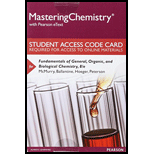
Concept explainers
Interpretation: The correct formula of the given ionic compound to be predicted.
Concept Introduction:
Polyatomic Ions: An ion that is composed of more than one atom.
Ionic compound: A compound that contains ionic bonds.
Naming Ionic compounds:
Once the number and kinds of ions in a compound are known, the formula is written using the following rules;
- List the cation first then the anion.
- Do write the charge of the
transition metal cation in Roman numeral.
Naming polyatomic Ions:
When anions contain the same two types of atoms and one of them is oxygen, the one with the fewer oxygen atoms is named with an ‘-ite’ ending and the one with the greater number of oxygen atoms is named with an ‘-ate’ ending.
The prefix ‘per-’ is used for the ion with the most oxygen atoms. ‘Hypo-’ is used for the ion with the least oxygen atoms.
Naming Anions: Anions are named by replacing the end of the element name with ‘-ide’, followed by the word ‘ion’.
Want to see the full answer?
Check out a sample textbook solution
Chapter 3 Solutions
Mastering Chemistry with Pearson eText -- Standalone Access Card -- for Fundamentals of General, Organic, and Biological Chemistry (8th Edition)
- Using the Nernst equation, calculate the equilibrium potential for Ca2 and for C1 from the following sets of data: a. Given [ Ca2+ ]0=1mM,[ Ca2+ ]i=100nM, find Eca2+ b. Given [ Cl- ]0=110mM,[ Cl- ]i=100mM, find Eclarrow_forwardWhat are the roles of globulins?arrow_forwardNitric oxide (NO) is a gaseous molecule with lipid solubility similar to that of O2 and CO2. Endothelial cells lining arteries use NO to signal surrounding smooth muscle cells to relax, thereby increasing blood flow. What mechanism or mechanisms would transport NO from where it is produced in the cytoplasm of an endothelial cell into the cytoplasm of a smooth muscle cell, where it acts?arrow_forward
- What are the two critical amino acids near the heme group in both myoglobin and hemoglobin?arrow_forwardWhat is the coordinate for this TSS?arrow_forwardAccording to Aristotle’s density equation, if 3.161 grams of the sugar sucrose (C12H22O11) occupies a volume of 2.0 cubic centimeters, then sucrose must have a density of: 0.6327 grams/cm3 B. 1.5805 grams/cm3 2.322 grams/cm3 10.322 grams/cm3 25.288 grams/cm3arrow_forward
- Glucose reacts slowly with hemoglobin and other proteins to form covalent compounds. Why is glucose reactive? What is the nature of the adduct formed?arrow_forwardWhat is centriole ?arrow_forwardGive possible biochemistry explanation why the American Heart Association recommend the use of canola oil or olive oil rather than coconut oil in cooking?arrow_forward
 Human Physiology: From Cells to Systems (MindTap ...BiologyISBN:9781285866932Author:Lauralee SherwoodPublisher:Cengage Learning
Human Physiology: From Cells to Systems (MindTap ...BiologyISBN:9781285866932Author:Lauralee SherwoodPublisher:Cengage Learning


